- Best VBScript Interview Questions & Answers
- Flutter vs React Native - What's the Difference?
- Flutter vs Ionic - What's the Difference?
- QuickBooks Interview Questions
- Windows Server Interview Questions
- Windows Administrator Interview Questions
- Power Automate – Tutorial
- TestRail Tutorial
- Rust Tutorial
- Rust Interview Questions
- Workato Interview Questions
- Test Page
- dummy page
Redis is an in-memory data structure store that is used as a cache, database, and message broker with optional durability. It is an open-source store. We can use Redis with streaming solutions, including Amazon Kinesis and Apache Kafka, for ingesting, processing, and analyzing real-time data. And there is a latency of just a sub-millisecond.
Redis comes at the top when it comes to real-time analytics like ad targeting, media analytics, IoT, and personalization. Several kinds of abstract data structures are supported by Redis, including lists, strings, maps, streams, sets, bitmaps, etc. This software, written in C language, was initially released in 2009.
Before moving further, have a look at the following important insights on Redis-
- The market share of Redis in the in-memory data store market is a whopping 88.54%
- Machine Learning, Technology, and Software Development are the top three Redis in-memory data stores using industries.
- The top three locations using Redis as an in-memory data store are the United States, India, and United Kingdom.
- The average salary of a software engineer with the knowledge of Redis is around $116,938 per annum. The salary varies from $85,000 per annum at the entry level to $148,000 per annum for experienced professionals.
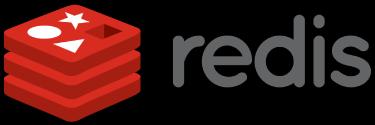
As we have gained a basic idea about Redis, let's us move to the Redis Interview Questions- updated (2022) and answers separately for the following-
Top 10 Redis Interview Questions:
Redis Interview Questions and Answers for the Freshers:
1. List the main operation keys of Redis.
The main operation keys of Redis are given below-
- TTL key
- TYPE key
- EXISTS key
- EXPIRE key seconds
- DEL key
- EXPIREAT key timestamp
2. How can the durability of Redis be enhanced?
We can enhance the durability of Redis by the given methods-
- We should call Fsysnc() with every passing second despite the 1-second data loss when the system gets failed.
- We should call Fsysnc() when a new command gets added to the append log file.
3. How can the Redis be used with the .Net application?
The given steps need to be followed in order to use Redis with the .Net application-
- Download Redis Server
- Install Redis server
- Download Redis client
- Set configuration into the Web. config File
- Use Redis client class
4. Differentiate between Redis and Memcached.
| Redis | Memcached |
| Data replication is supported. | Data replication is not supported. |
| It is a single-threaded architecture. | It is a multi-threaded architecture. |
| We can use several data types here. | We can use only the strings data type in here. |
5. Differentiate between Redis and MongoDB.
| Redis | MongoDB |
| It is a key-value store. | It is a document type of store. |
| It is relatively faster. | It is relatively slower. |
| It uses C language. | It uses C++ language. |
| Lua is the server-side script here. | JavaScript is the server-side script here. |
6. How can a Redis database be emptied?
We can use the two commands given below for emptying the database-
- FLUSHALL- It will remove the data from all databases. The syntax is given below-
Redis-CLI flushall - FLUSHDB- It will remove all the data from the database that is currently in use by the user. The syntax is given below-
Redis-CLI flushdb
7. Mention and describe some commands of Redis.
Some of the Redis commands and their descriptions are given below-
- AUTH- It authenticates to the server.
- APPEND- It appends a value to the key.
- BITCOUNT- It counts set bits in a string.
- BGSAVE- It saves the dataset asynchronously to disk.
- CLIENT LIST- It gets the client connections list.
- BGREWRITEAOF- It re-writes the append-only file asynchronously.
- CLUSTER INFO- It provides information about the cluster node state of Redis.
| Want to enhance your skills in dealing with the world's best NoSQL Database Courses, enroll in our: “MongoDB Training” Course. |
8. Explain REPL and Redis-CLI.
The full form of REPL is Read Eval Print Loop. It is a modern interactive mode where the commands can be typed by the users to get replies.
Redis-CLI means the Redis interface of the command line. It is a simple program that enables the users to send commands to Redis directly from the terminal and get the replies that are sent by the server.
9. What is meant by hashes in Redis?
String names are mapped to the string values by these Redis hashes. These contain unique fields as well as their values. They are considered the perfect way of representing an object in the form of a Redis data structure. The constant time basic operations are provided by the hashes like the set, get, exist, etc.

10. What is meant by ZSET in Redis?
ZSET means a Redis Sorted Set where we can document a Redis data type. Each key in the assorted set contains multiple values associated with a value score that is floating. Redis provides the unique feature of accessing it by a member such as a HASH. Also, we can access the items by the sorted order as well as the values of the scores.

11. Explain the list operations available in Redis.
The list operations are given below-
- LPOP- An element is removed from the head by it.
- RPOP- An element is removed from the tail by it.
- LPUSH- A new element is inserted on the head by this operation.
- RPUSH- A new element is inserted on the head by this operation.
- LRANGE- An element is printed from the specified position
12. Explain the SET operations of Redis.
- The SET operations are given below-
- SMEMBERS- Values from the KEY are retrieved.
- SADD- A new element is added to the set.
- SISMEMBER- The presence of a specified element is verified in the SET.
- SPOP- The element is popped out from the SET.
13. How can Redis be started?
The given path can be followed to start Redis-
/etc/init.d/redis-server start
14. How can Redis be started?
The given path can be followed to re-start Redis-
/etc/init.d/redis-server restart
15. How can Redis be stopped?
The given path can be followed to stop Redis-
/etc/init.d/redis-server stop
Redis Interview Questions and Answers for the Experienced:
1. How does overriding a value using set differ from overriding using append?
The value for the key will be set by the SET command. And the value will get overridden by doing it over and again.
On the other hand, the append contains the effect of the set only when there is no value of the key earlier. If the key already has a value assigned, then appending the key results in a value appended to the key's existing value.
2. What is meant by data modeling in Redis?
The data modeling contains the pattern and name of the data structures that should be used for storing data to achieve a dominant requirement. This is like most other databases. For instance, the primary key is used in the relational database world for establishing a relationship between two objects. In relational databases, the data is stored in a table format, while Redis contains the data structure used for representing the domain data. We need a different design mindset for converting a relational dataset to a Redis dataset.
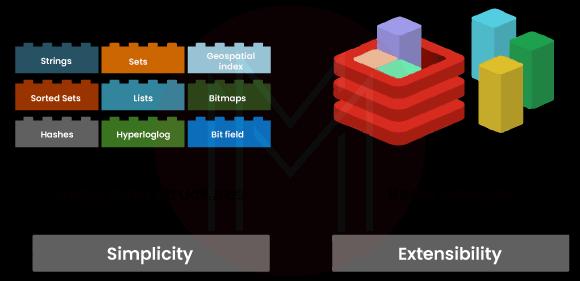
3. How can a Redis database be moved from one server to another server?
A Redis database can be moved from one server to another in the following way-
- Save a snapshot into dump.rdb of the database using the BGSAVE command.
- Now, this dumb.rdb file needs to be copied into another server as required.
4. How can the array data be obtained from Redis?
We can get the array data from Redis by using the given commands-
$list = $redis ->lrange (“tutorials”, 0, 5);
print_r($list);
/*array ([0] => Mysql [1] => Mongodb [2] => Redis [3] => MySQL [4]=> PHP [5] => Mysql)*/5. What is meant by "Redis is Binary Safe"?
Binary Safe represents having a known length, but no special character limits it. Any value can be stored by the user up to the given size. A string value can have a length of 512 MB.
6. How can the running of Redis be checked?
We can check if the Redis is running using the given commands-
try
{
$redis = new Redis();
$redis -> connect (‘127.0.0.1’, 6379);
echo “Redis is running.”;
echo “Server is running:”. $redis -> ping()
}
catch (Exception $e)
{
echo $e -> getMessage();
}7. Which things should be kept in mind while using Redis?
The following things should be kept in mind-
- Consistent methods like Namespace management should be used for naming and prefixing the keys.
- Register key prefixes such that every document can be mapped to its owner application.
- Design, implement, and test the mechanism of garbage collection for each class of the Redis architecture that we are keeping.
- A sharding library should be maintained before investing in the application.
8. Are transactions supported by Redis?
EXEC, MULTI, WATCH, and DISCARD are the foundations of Redis transactions. A group of commands can be executed in a single step by these. And the following two important guarantees are there-
- All the commands are executed and serialized in a transaction sequentially. A request issued by some other client can never be served in the middle of the Redis transaction's execution. Single isolated execution of the commands is guaranteed by it.
- A Redis transaction is atomic; that is, either all or none of the commands are processed.
9. Differentiate between sharding and replication in Redis.
- Sharding, also called partitioning, refers to the data's splitting by the key. We use sharding to increase performance and to reduce the hit as well as memory load on a single resource.
- Replication, also called mirroring, refers to copying all the data. This helps to get high availability of reads. The hit rate on all the resources will reduce if you are reading from multiple replicas. But the memory requirement remains the same for all the resources.
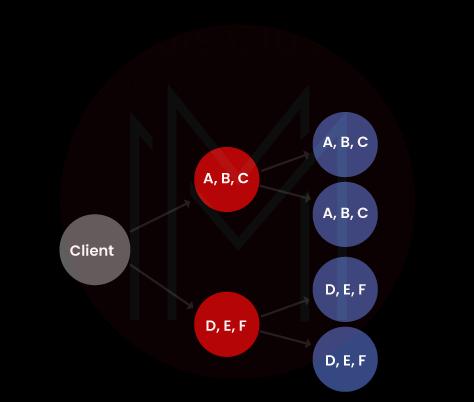
10. How would you explain the list's blocking operations?
This situation arises when the list is already empty, and we want the operations like LPOP/RPOP to be removed. Here, nothing will get done by the removal operation. The user will have to wait for some time and then try again with RPOP.
Therefore, Redis provides the commands known as BRPOP and BLPOP (the versions of POP and LPOP) to block when the list is empty. Only when it reaches the timeout specified by the user, or a new element gets added to the list the caller will be returned.
11. What is meant by SUNION and SINTER?
SUNION- The members of the set are returned from the union of all the sets that are given.
SINTER- The members of the set are returned that result from the intersection of all the sets that are given.
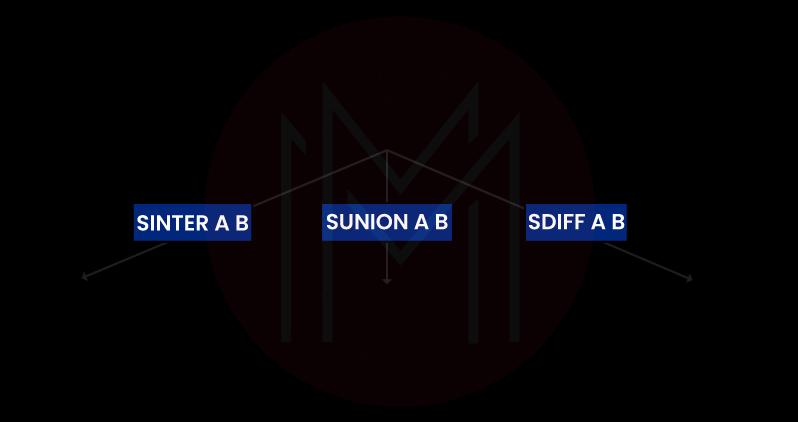
12. What is meant by SUNIONSTORE and SINTERSTORE?
SUNTIONSTORE- This command resembles the SUNION command, but the resulting set is stored in the destination instead of getting returned.
SINTERSTORE- This command resembles the SINTER command, but again the resulting set is stored in the destination instead of getting returned.
13. Explain the data-type operations of HASH.
- HMSET- The specified fields are set to their respective values in the hash that is stored at the key.
- HGET- The values associated with the field are returned in the hash that is stored at the key.
- HGETALL- All the values and fields of the hash that are stored at the key are returned.
14. Explain the Sorted Set operations of Redis.
- ZADD- All the specified numbers are added with the specified scores to the sorted set that is stored at the key.
- ZREM- Specified numbers from the sorted set that are stored at the key are removed. It ignores the non-existing members.
- ZRANGE- Specified range of elements in the sorted set that is stored at key is returned.
- ZRANGEBTSCORE- All the elements with a score between the minimum and maximum in the sorted set at key are returned.
15. How is persistence achieved by Redis through Snapshotting?
The data is taken and written to the disk by Snapshot in cases of system crash to avoid data loss. This file is referenced as "dbfilename". The five ways for initiating the snapshots are given below-
- BGSAVE
- SAVE
- From configuration files
- SHUTDOWN
- Sync with other Redis
| Check Out: MongoDB Interview Questions |
Frequently Asked Redis Interview Questions and Answers:
1. List the major companies that use Redis as an in-memory data store.
The list of major companies that use Redis as an in-memory data store is given below-
- GitHub
- Twitter
- Snapchat
- StackOverflow
- Craiglist
- Instagram
- Udemy
- Uber
2. Mention some popular tools that integrate with Redis.
Some popular tools that can integrate with Redis are-
- Presto
- Datadog
- Spring Data
- Netdata
- n8n
- Google Cloud
- Heroku Redis
- Clever Cloud
3. List down the main features of Redis.
The main features of Redis are given below-
- Redis is fast software capable of executing 100000 queries in a single second.
- Installing and managing Redis is very easy.
- Redis loads the data in primary memory, which is also the reason for it being superfast.
- Various kinds of data structures are supported by Redis, including sets, hashes, strings, lists, etc.
- Redis has atomic operations to work on different types of data.
- Simple master is supported by Redis to slave replication.
- Our client library can also be written in case the required language is not yet supported.
- Redis is portable.
4. What are some of the languages supported by Redis?
The following languages are supported by Redis-
- C
- C++
- C#
- Python
- Java
- Erlang
- PHP
- Scala
5. In which language is Redis written?
ANSI C is the language in which Redis is written. It is mostly used for session management and cache solution. And unique keys are created by it for store values.
6. Why do you use Redis?
Redis is a key-value database store. It is capable of functioning as a NoSQL database or as a cache store for memory. This improves the performance when working with the data that is stored in the memory of the system.
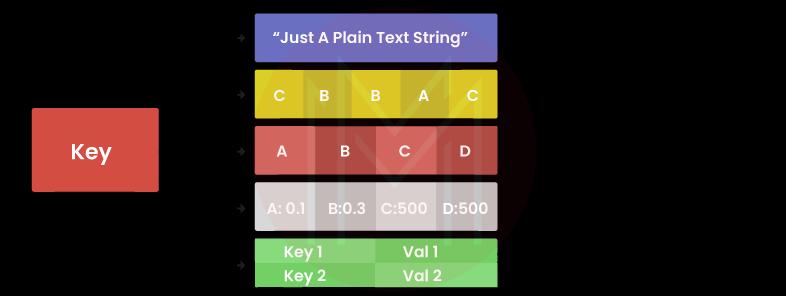
7. How does Redis differ from most other databases?
Redis is an open-source, NoSQL, and in-memory data structure store. The principle of a key-value store is followed by Redis.
It is very persistent, fast, portable, and supports several languages like Java, Python, C, C++, R, Scala, Lua, JavaScript, Ruby, Rust, Tcl, Go, etc.
8. How do you interact with Redis?
After installing the server, we can run the Redis Client that is provided by installing Redis, or the command prompt can be opened. Then we can use the command given below-
Redis-CLI9. What is the replication feature of Redis?
Replication is an essential feature for achieving high-level availability in huge data systems. We need to replicate the data at n number of places. The master-slave approach is used where it maintains the master copy and replicates it to n other nodes.
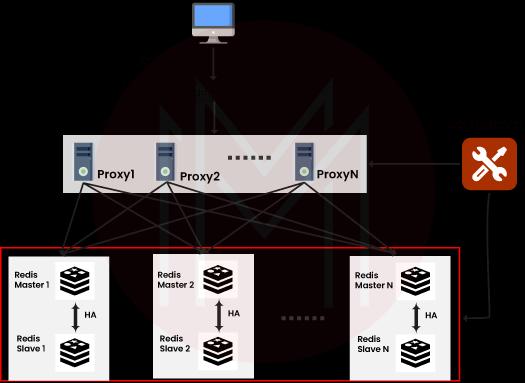
10. Differentiate between RDBMS and Redis.
Some of the differences are given below-
- Redis is comparatively faster than RDBMS.
- Redis is a NoSQL database, whereas RDBMS is an AQL database.
- The dataset of Redis is stored in primary memory, whereas the dataset of RDBMS is stored in the secondary memory.
- The key-value structure is followed by Redis, whereas the table structure is followed by RDBMS.
- Small files are generally stored in Redis, whereas large files are stored in RDBMS.
Conclusion:
The Redis developers are in high demand, and this demand is on the ever-growing path. The demand is rising because the startups and the existing major companies both are expanding at a high pace. The salary varies as per experience. But as the experience increases, the salary gets increased by an even high multiple. And so increases the competition. Therefore, make sure you are well-prepared with these Redis Interview Questions if you don't want to miss your chance.
 On-Job Support Service
On-Job Support Service
Online Work Support for your on-job roles.

Our work-support plans provide precise options as per your project tasks. Whether you are a newbie or an experienced professional seeking assistance in completing project tasks, we are here with the following plans to meet your custom needs:
- Pay Per Hour
- Pay Per Week
- Monthly
| Name | Dates | |
|---|---|---|
| MongoDB Training | Dec 13 to Dec 28 | View Details |
| MongoDB Training | Dec 16 to Dec 31 | View Details |
| MongoDB Training | Dec 20 to Jan 04 | View Details |
| MongoDB Training | Dec 23 to Jan 07 | View Details |





